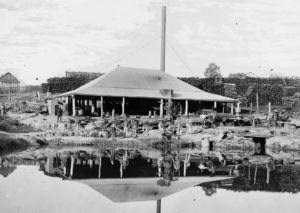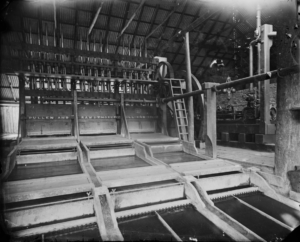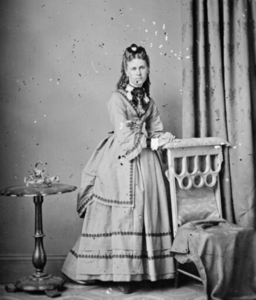
Imagine having such a trail-blazing life as a pioneer that when summing it up you barely mention that you were the Pullen – of Pullen & Rawsthorne fame – who designed and operated the stamper battery that crushed Holtermann’s quartz to extract his considerable gold finds! Such is the case of William Toft Pullen who came to our attention at the request of a descendant who emailed the Gulgong Holtermann Museum seeking photos.
William Toft Pullen was the grandson of James Toft, a convict who died from dysentery at Rio de Janeiro en route to Australia. Pullen’s first job in Sydney in the 1840s was call-boy at the Royal Victoria Theatre (where his father worked as a mechanic). After that he was apprenticed to a cabinetmaker and undertaker. In 1851, at the age of 17, he ran away from Sydney – with two shillings, a single-barrelled gun – to the Summer Hill goldfields near Bathurst:
When I reached Bathurst I bought a cradle to wash the gold, and walked the 34 miles to the goldfields … and I could not resist the temptation of trying some dirt immediately I arrived. My luck was in from the start, as I got a little gold from the first dish I washed, and I got the gold fever right there.
In 1853, after he’d worked out his claim and split £1500 with his partner, Pullen got well-paid work cutting boards for sluicing at Adelong. In 1854 he married and moved to Hargraves where many men were employed crushing quartz but Pullen was involved in alluvial work. Six of his eleven children were born in the decade he spent in the Mudgee district. From there, in 1868, he bought a crushing plant and moved with it from Hargraves to Hill End. He then commissioned a much larger stamper battery to be built and hauled from Sydney to Hill End and that’s when the serious crushing began.
I started crushing with the battery, and ultimately got good values. I crushed all that rich lot of stone for Messrs. Beyers and Holtermann in ’72, and I think this forms the world’s record. We got about 11,000 oz. of gold – worth about £15,000 – from about 15 tons of stone … Beyers and Holtermann got about £60,000 each from their claim.
Alas, for all the popularity of the machine, and all the wealth it generated for miners, Pullen and Rawsthorne faced insolvency in 1875 with estimated liabilities of over £3118 and only £28 in assets!
Undaunted, Pullen emerged as a businessman on the Clarence, and with considerable success but later decided to grow and manufacture sugar at Woolgoolga, still an untouched wilderness of rainforest where the Aboriginal people “hunted through the sombre timber belts or fished in the bountiful and numerous lagoons”. Pullen brought in the necessary machinery by sea!
The hardy pioneer was left to his own resources, supported by indomitable courage and unswerving will-power. He landed his machinery through the surf; he shipped his sugar and subsequently his timber through the surf or over the rocks. Later he built a jetty.
Despite his early birth year, 1834, there are a number of photos to accompany Pullen’s life story. His wife and children appear in a photo of their home at Hill End and two of the older children, Rebecca and William were captured in portraits taken my Merlin and Bayliss in the Hill End years. The Pullen and Rawsthorne stamper battery was the subject of many photos in the Holtermann Collection. Much later, in 1905, a large family gathering was photographed on the occasion of William and Charlotte’s 50th wedding anniversary, capturing four generations of his family. When William died in 1917 at the age of 82, he left a widow, five sons, and four daughters, as well as over 70 descendants, including six fighting at the front. His life’s work lives on in interviews, stories and photographs. You can read a fuller account of his life or you can read about advancements in quartz crushing in the Online History of Gulgong.
Photo sources:
- House [of W.T. Pullen], Tambaroora Street, Hill End, Mitchell Library, SLNSW
- Portrait of William Toft Pullen (enhanced), Coffs collections
- Pullen and Rawsthorne’s stamper battery at the southern end of Clarke Street, Hill End, Mitchell Library, SLNSW
- Pullen and Rawsthorne’s “Little Wonder” Stamper Battery, opposite the southern end of Clarke Street, Hill End, Mitchell Library, SLNSW
-
Miss [Rebecca Ann] Pullen, Mitchell Library, SLNSW
-
Master William Pullen, Mitchell Library, SLNSW
Click on the links to view the original high-resolution images via the State Library website and elsewhere.





